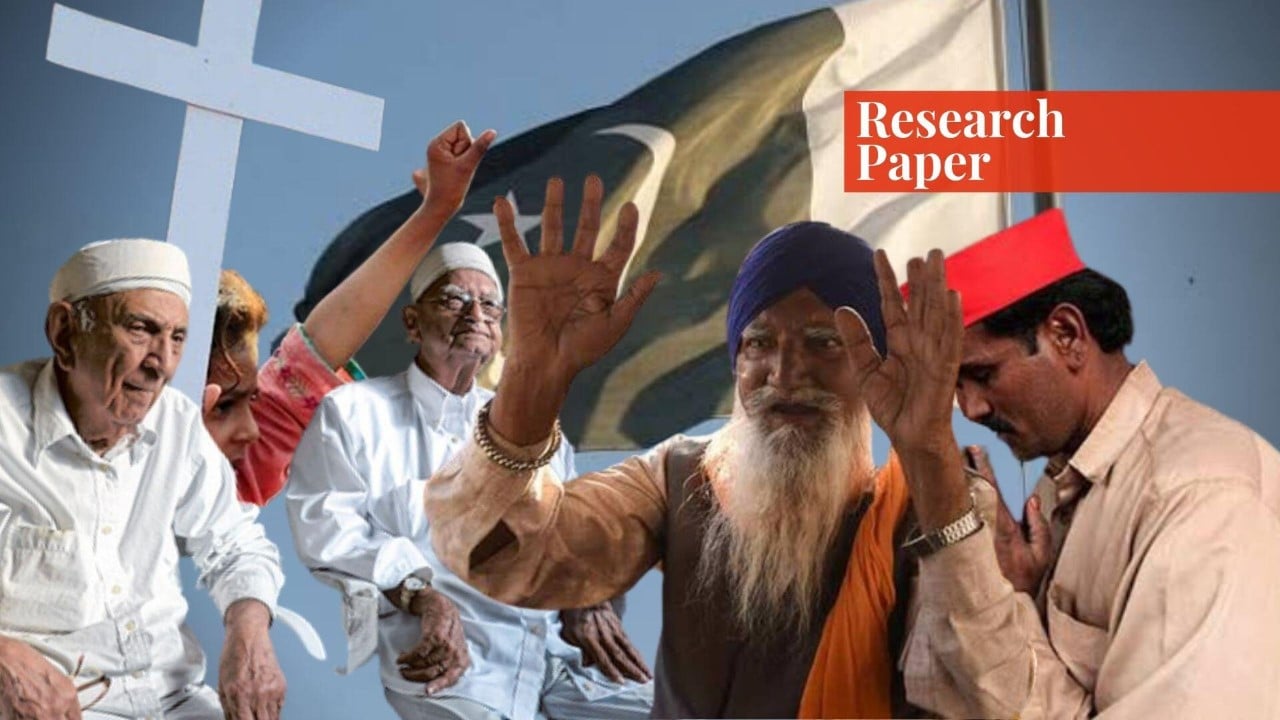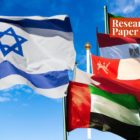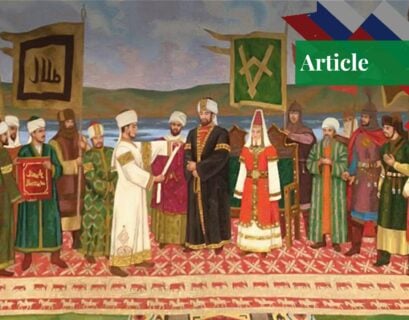The Vision of Pakistan
The raison d’etre behind Pakistan’s formation was the need for a separate homeland for the Muslim minority in the subcontinent who were persecuted by British and Hindu leadership (Saeed, 2016, p. 3). Initially, it felt that the Muslim majority of Pakistan would not let its past mistreatment hinder the protection of its own minorities. “…the new state nonetheless championed equality between different faiths” (Misra, 2015, p. 159).
Muhammad Ali Jinnah’s vision was to make sure that religion and state function distinctly in Pakistan with no possible overlap. His ideology is reflected in his speech on August 11, 1947, “You may belong to any religion or caste or creed – that has nothing to do with the business of the state” (Malik, 2002, p. 8). However, this vision was “short-lived” and died with Jinnah (Misra, 2015, p. 159).
Beginning in the 1970s, “a long arduous and painful journey began” for the minorities of Pakistan, and thus a state that initially preached the message of equality ended up depriving its minorities of the very same (Bokhari, 2020, p. 323). The Muslims in Pakistan have forgotten that non-Muslims played a cardinal role in Pakistan’s formation.
Pernicious Interpretations
In the earlier constitutions, Christians were initially regarded as a model minority and guaranteed equal rights as Muslims. However, when the subsequent governments wore a blindfold in the longing for illegitimate power and continuing support, “egregious” violence against Christians led by the Muslim majority became prevalent and widespread (Misra, 2015, pp. 158-159).
The constitution and judicial interpretations attempt to offer bare minimum protection to minorities in Pakistan. However, restrained rights, governmental mismanagements, flawed blasphemy laws, and mob mentality deprive minorities of safeguarded rights and safety as much as Muslims.
Pew Research Center’s report reflected that Pakistan had the highest level of social hostilities involving religion (Misra 159-160). This topic receives limelight because, on December 3, 2021, a mob in Sialkot tortured a Sri Lankan national working in Pakistan as a manager over alleged blasphemy and burned his body, reestablishing Pakistan as an unsafe country for religious minorities (Sadiq).
Is the Constitution Still a Guarantor of Rights and Freedoms?
From the perspective of the supreme law of the land, the constitution tries to guarantee some basic fundamental rights to minorities, but these rights are not absolute; instead, their spectrum has been narrowed down by the use of vague and discretionary terminology. The objective resolution, which was initially the preamble of all three constitutions, was made enforceable by Article 2-A into the constitution.
Before incorporation, it read that minorities had the right to “freely profess and practise their religions.” The term “freely” was removed when it was made enforceable, and it was only included after the 18th amendment. Article 19, which provides freedom of speech to citizens, has been restricted by the terminology “in the interest of the glory of Islam” (Khan).
Such restriction on fundamental rights leaves a grey area that authoritarians have misused to validate their inhumane actions. “Article 19 of the Pakistani Constitution can be used to derive legitimacy for the current blasphemy laws in Pakistan, as amended by General Zia-ul-Haq during the 1980s, which are deemed as infringing upon not only religious freedom but freedom of expression as well” (Iqbal).
Although the constitution guarantees the right of minorities to practice and profess their religion in Article 20, the way it has been interpreted has proved to be troublesome. Pakistan has witnessed several governments in its history that have particularly infringed upon minority rights to appease religious parties in order to continue their tenure unobstructed.
Zia’s Role in Ostracizing Religious Minorities
Zulfiqar Ali Bhutto amended article 260(3) of the constitution to include a negative definition of a Muslim just to declare the Ahmadi community non-Muslim. He did this in “pursuit of further popularity among the religious elements” (Malik 8). This restricts the freedom of religion because the state defines whether it regards someone as Muslim or not.
Zia Ul Haq’s military regime further deprived the non-Muslims in Pakistan. He introduced courts, ordinances, and constitutional amendments mainly targeting non-Muslims. The motivation behind this was to appease the “clerical groups such as the J.I. and other conservative elements” with whose support Zia had come into power (Malik 10).
Under Article 203, the Federal Shariat Court was established, declaring any law ‘defunct’ if it did not conform with Islam. Under article 228, the Council of Islamic Ideology was formulated, which oversaw legislation. Zia promulgated Ordinance XX, which criminalized Ahmadis, and successfully committed to creating a Sunni majoritarian state by converting secular laws to religious ones (Misra 160-161).
With the promulgation of these laws and ordinances, Zia ul Haq marginalized the minorities in Pakistan with no regard for their religion. Mainly targeting the Ahmadis, he ensured they were not even given the same status as other non-muslims. When the question of judicial interpretation of the constitutional freedom of religion is brought into the debate, the judiciary is seen making some attempts to safeguard minorities.
However, this was before the religious politicization of courts by Zia-ul-Haq. Post-1960s judiciary increasingly made attempts to substitute the Constitution with Islamic laws. However, Islam was given a flexible and dynamic interpretation to defend the minorities. Judges relied on Quranic verses that supported the idea of freedom of religion to ensure that the rights of minorities were intact.
In the case of “Abdul Karim Shorish Kishori v The State Of West Pakistan PLD 1969 Lahore 289,” courts relied on Islamic verses to protect the Ahmadi community’s right to profess their religion and held writing of anti-Ahmadi literature completely unjust (Saeed 182-185). However, Saeed stresses that this was merely achieved because of Sharia’s “flexible” and “dynamic” application. If Sharia had been interpreted rigidly, the decision would have been against the minorities (Saeed 186).
Islam was again interpreted as a safeguard for minority rights in the case of “Abdul Rehman Mobashir v Amir Ali Shah PLD 1978 Lahore 113”. Judicial interpretation played a crucial role in deciding the future for minorities. Judges interpreted Islam dynamically before Zia’s tenure to relieve minorities. However, during Zia’s tenure, a general atmosphere of vast scale infringement of minority rights greatly affected the judiciary.
The Relentless Persecution of Ahmadis
Zia’s exercise of control over the judiciary was a manifestation of broader state repression of all political and cultural dissent (Toor 125-130). In order to seek official verification for his regime, Zia promulgated the Provisional Constitution Order, which required judges to take an oath to continue their jobs. This “almost choked the judiciary and virtually curbed dissent” (Saeed 192).
Furthermore, Saeed looks at Zia’s measure of enactment of Federal Shariat Courts as “cautionary, gradualistic and to some extent deliberately vague” (193). When Zia made the objective resolution an enforceable part of the constitution, he initiated a conflict between the sovereignty of Allah and fundamental rights vested by the constitution (Lau 48). Ahmadis challenged the 2nd amendment because it violated Sharia and the constitutional right to practice religion freely.
Justice Aftab Hussain, who had penned down the judgment in the Mobashir case referred above, was replaced before the final judgment. This shows a shift from the “egalitarian” Sharia that protected the religious rights of Ahmadis. After this, the Ahmadis challenged the 1984 Ordinance in Federal Shariat Court, but the petition was dismissed because it did not violate the constitutional right of Ahmadis to profess their religion freely.
With this failure, Ahmadis challenged the Ordinance in Supreme Court in the case of “Zaheerudin v The State (1993) SCMR”. It was ironic that Islam, which used to protect minorities, was now used as the very tool to slaughter their rights. The reasoning for this was that the Ordinance was “based on Sharia which held supremacy over constitutional provisions guaranteeing the right of religious freedom” (Saeed 201).
Marva Khan refers to the 3 out of 5 majority judgment to the “Coca-Cola” judgment because the Supreme Court used an analogy with the Coca Cola trademark since they have the discretion to choose whom they shared their recipe with, so courts, too, have the discretion on whom they allow usage of Muslims nomenclature. Furthermore, unlike other religions, people cannot distinguish between Ahmadis and Muslims.
This two-tier judgment further restricted the right to practice religion. This judgment depicts a shift in the judiciary’s attitude towards the non-muslims. Their minority protective attitude took a wrong turn with the arrival of Zia in power. However, it cannot be neglected that the landmark judgment by Justice Tassaduq Jillani tried to reform the way minorities had been treated.
The Supreme Court Takes Matters into Its Own Hands
The Peshawar church attacks of 2014, the forced Hindu conversions, the desecration of Hindu temples, the threats to the Kalash tribe and Ismailis in Chitral, and several other issues led the Supreme Court to take a suo moto notice (Dawn). The judgment came on June 19, 2014, and it stands out in two ways, firstly it interpreted the constitution to give inclusion to minorities, and secondly, it gave directives to both provincial and federal governments to take expedient measures for the protection of minorities.
Instead of issuing orders for only selected and specific cases, the Court gave directions to provide institutions and mechanisms to redress these issues in the long term. Article 20, i.e., freedom of religion, is not rigidly defined in the decision but is construed to include freedom of conscience, thought, expression, belief, and faith. Furthermore, the right to religion is read to give freedom to minorities to practice their religion both publicly and privately and emphasizes that all citizens are equal and will enjoy equal rights as enshrined in the constitution (S.M.C. No 1/2014).
Marva Khan believes this was the first time in Pakistan’s history when minorities were not regarded as the ‘other’ and viewed equally as majority Muslims. “Barrister Asad Rahim Khan says that this judgment righted many historical wrongs, and has gone some distance towards being implemented” (Malik). The judgment gave eight overarching directives, but their importance has been restricted to paper, and little has been done to implement them in letter and spirit.
Peter Jacob analyzes the progress regarding these directives in his book “Justice Yet Afar.” One of the directives required formulating a National Council for minority rights to practically realize and safeguard minority interests. In practicality, this institution was formulated in the 1990s, but it is not an autonomous institution. It has been filled with government officers and holds merely a face value for Pakistan.
Whenever any international treaties require a name of a minority organization, only the name of this institution is used with practically no power vested in it. A bill is currently in the process for an autonomous institute for minorities to be formulated; if that bill is passed, it will be a step in the right direction. No work has been done about formulating a special task force to protect the places of worship of minorities.
Regarding the directive requiring appropriate curricula for minorities, the PTI government introduced the Single National Curriculum requiring the drafting of separate books for each religion, and that minorities be taught the religion they embrace. However, it is not perfect because some religious elements in other disciplines need to be strictly confined to Islamiat.
The Evacuee Trust Property Board has miserably failed in protecting the religious institution of minorities. It monitors only 30 out of the 331 religious places that fall in its jurisdiction. As a result, the Shri Hans Ji Maharaj temple has been repeatedly desecrated. Moreover, the judgment required the formulation of a Supreme Court bench to overlook the practical manifestation of these directives and take up complaints related to minority rights; this was acted upon, and the bench has heard 23 hearings to date. However, it was not functional between 2015 and 2016.
For closer regulation of minorities, a Commission was formulated under Dr. Shoaib Suddle to bridge the gap between the executive and the judiciary. This commission has been a one-off initiative taken by Pakistan, but it faces a lack of finance. Provincial governments have fixed a job quota for minorities, but it has not been realized because minorities occupy only an average of 50 percent of these quota seats. The rest remain vacant. The court held the executive accountable and demanded that the root cause behind this problem be identified and resolved (Jacob 39-82).
The Insertion of Blasphemy Laws
The primary step that cascaded minority rights into an abyss was the enactment of blasphemy laws. General Zia’s tenure of Islamizing Pakistan is read as a turning point in the history of minorities (Waseem et al.). The British initially introduced blasphemy laws as part of hate speech laws to outlaw the inflaming of religious hatred” (Malik 18). Pakistan retained these laws in its penal code as section 295 and 295-A.
Marva Khan believes that these were generic provisions applied across the board to all religions. Anyone could not intentionally hurt the religious sentiments of someone; only when the malicious intent was proved, the law would take charge. However, Zia-ul-Haq amended these blasphemy laws through ordinances to include Section 295-B and C; this was his attempt to please Islamicists.
The problem with the current blasphemy laws is that intention crucial to criminal cases is not given any importance in the text of these amended laws (Malik 18-19). Moreover, “the most damning aspect of this hegemonic design is that the controversial blasphemy law permits any Muslim (read Sunni Muslim in this context) to accuse a person of insulting Islam without having to produce evidence” (Mohsin).
Marva khan elaborates that judges have failed to look at the evidence in accused blasphemy cases because they believe that reiteration of the sentences used by the accused will make them the blasphemer. In this faulty line of reasoning, accusing a person of blasphemy becomes too convenient with no regard for evidence. This is why Misra points out that blasphemy is often used by the local power elite, mainly feudal landlords, as a pretext to appropriate their labor, land, and women (163).
The implications of these blasphemy laws have been problematic for both Muslims and non-Muslims. After the death penalty was included as a punishment for blasphemy, 1274 people from various sects, e.g., Ahmadis, Hindus, Sikhs, Christians, and Muslims, were accused of blasphemy (Siddiqi). This means that thousands of families have been desolated, settlements have been destroyed, people have been forced to leave their houses, and many are suffering incarceration because of false accusations (Bokari 327).
In one of the initial blasphemy cases in February 1997, an enraged Muslim mob attacked Shanti Nagar, a Christian settlement, destroying 850 houses, 13 churches and causing displacement of 2500 Christians (Bokhari 327). The case that stands out is that of Aasia Bibi, a 47-year-old Christian, who was sentenced to death in a blasphemy case by a Sessions court that the High Court upheld. After eight years, the Supreme Court overturned the decision because “the prosecution was not able to prove the case beyond reasonable doubt” (Iqbal).
The fact that it took eight years to bring justice for Aasia Bibi is viewed by the Human Rights Commission of Pakistan as a “sobering thought” (Hasan). Internationally, there were large-scale appeals for the acquittal of Aasia Bibi; Pope Benedict and Pope Francis voiced for the release of Aasia Bibi. There were several petitions to free Aasia, and a petition by the voice of martyrs alone received 400,000 signatures (Voice of Martyrs).
The case of Aasia Bibi underlines the fact that, like many other fragile democracies, one of the most challenging parts of enforcing the blasphemy laws in Pakistan is that the presumption of innocence is violated. Before being tried in the court of justice, the accused is tried at the society’s Court, which sentences them based on its evaluation. It is all too easy to be blinded by moral fury.
The Volatile Society
In this highly radicalized environment, throughout society, enormous crowds swell at the drop of a hat, calling for the accused’s blood, and this heinous response usually pits the helpless against the powerful. From religious extremism’s onslaught, Aasia Bibi was taken from her husband and children and imprisoned to be sacrificed at the altar because of this terrible law. The judges who were hearing Asia Bibi’s case even received death threats.
Former Punjab Minister Salman Taseer and the federal Minister for minority affairs, Shahbaz Bhatti, who had been very vocal about the Asia Bibi case, were brutally murdered, the former by his guard (Bokhari 328). Marva Khan elaborates that Junaid Hafiz had a clash with the right-wing association in B.Z.U, asking him to resign or suffer the consequences. He did not resign and kept his job, and now he has been languishing in jail, awaiting trial.
This socially volatile attitude is one of the reasons why authorities have failed to do anything about this matter, even if they approach it with good faith. Malik points out that in 1994, the Benazir Bhutto government, which had initially agreed to review article 295-C, was forced to backtrack because of nationwide demonstrations (18).
An Unanswered Question
In conclusion, the question of minorities has been lingering since the inception of Pakistan. This question resurfaces when incidents like the Sialkot lynching take place. The causal role can be attributed to Zulfiqar Ali Bhutto and Zia-ul-Haq, who, in attempts of receiving the support of religious parties, dragged minorities into a fate of misery.
Judiciary played a fair role in minority protection before the Zia regime. After that, the judiciary disowned minorities, as did all the remaining institutions. A breakthrough came with Tasadduq Jillani judgment, but it remained restricted to paper. resurThe framework that it provided would have made a significant impact on the minority situation in Pakistan if it had been implemented. No major initiative has been taken for minorities ever since because religious intolerance has heightened in society.
Examples of Salman Taseer and Shahbaz Bhatti appear as a model for those who think about voicing for minorities, and this thought makes them withdraw. The primary root lies in society’s hatred, which effective curriculum reforms can correct. The Single National Curriculum, though not perfect, can be seen as an aid to resolve minority problems in the long run.
References
- “Activists rue non-implementation of Tassaduq Jilani verdict.” Dawn News, June 5, 2019, https://www.dawn.com/news/1486557. Accessed December 17, 2021.
- Bokhari, Sadia. “Protecting Religious Minority Women in Pakistan.” Corridors of Knowledge for Peace and Development, edited by Sarah S. Aneel et al., Sustainable Development Policy Institute, 2020, pp. 323–34, https://www.jstor.org/stable/resrep24374.27.
- Hasan, Mehdi. “After the Aasia Bibi Verdict, A Longer Battle.” Press Release, Human Rights Commission of Pakistan, November 1, 2018.
- Iqbal, Nasir. “SC Acquits Aasia of Blasphemy Charge, Orders her Release.” Dawn News, November 1, 2018, https://www.dawn.com/news/1442764. Accessed: December 17, 2021.
- Iqbal, Nasir. “CJ Lauds Parliament for Correcting Historic Wrong.” Dawn News, June 9, 2010, https://archives.dawn.com/archives/32657. Accessed December 17, 2021.
- Jacob, Peter. “Justice Yet Afar.” Center for Social Justice, April 15, 2021.
- Khan, Marva. “Constitutional Comparison and Analysis of Discrimination against Religious Minorities in Pakistan and India.” LUMS Law Journal, https://sahsol.lums.edu.pk/law-journal/constitutional-comparison-and-analysis-discrimination-against-religious-minorities. Accessed December 17, 2021.
- Lau, Martin. “The Role of Islam in the Legal System of Pakistan.” Leiden, Netherlands: Martinus Nijhoof, 2006.
- Malik, Hasnaat. “BULWARK FOR MINORITIES IN PAKISTAN.” Tribune, November 28, 2021, https://tribune.com.pk/story/2331336/bulwark-for-minorities-in-pakistan. Accessed December 17, 2021.
- Malik, Iftikhar. H. “Religious Minorities in Pakistan.” August 2002, https://www.refworld.org/docid/469cbfc30.html. Accessed 17 December 2021
- Misra, Amalendu. “Life in Brackets: Minority Christians and Hegemonic Violence in Pakistan.” International Journal on Minority and Group Rights, vol. 22, no. 2, Brill, 2015, pp. 157–81, https://www.jstor.org/stable/24676557.
- Mohsin, Saima. “Tackling Religious Intolerance and Violence in Pakistan.” CNN, September 24,2013, https://edition.cnn.com/2013/09/24/world/asia/pakistan-christians-mohsin/index.html. Accessed December 17, 2021.
- M. Waseem et al. “Dilemmas of Pride and Pain; Sectarian Conflict and Conflict Transformation in Pakistan, Religion & Development Working Paper 48.” International Development Department, University of Birmingham, Birmingham, 2010.
- Sadiq, Imran. “Sialkot mob lynches Sri Lankan factory manager, burns corpse over blasphemy allegations.” Dawn News, December 3, 2021, https://www.dawn.com/news/1661728. Accessed December 17, 2021.
- Saeed, S. “Politics of desecularization.” Cambridge University Press, 2016.
- Siddiqi, Tabina. “Accused under the Blasphemy Law.” Dawn News, September 19, 2012, https://www.dawn.com/news/750512. Accessed December 17, 2021.
- Toor, Saadia. “The State of Islam: Culture and Cold War Politics in Pakistan.” London: Pluto Press, 2011.
- Voice of Martyrs. “Asia Bibi, Prisoner Alert.” https://www.prisoneralert.com/pprofiles/vp_prisoner_197_profile.html Accessed December 17, 2021
If you want to submit your articles, research papers, and book reviews, please check the Submissions page.
The views and opinions expressed in this article/paper are the author’s own and do not necessarily reflect the editorial position of Paradigm Shift.



















